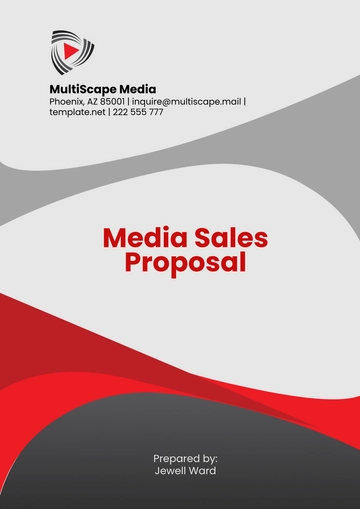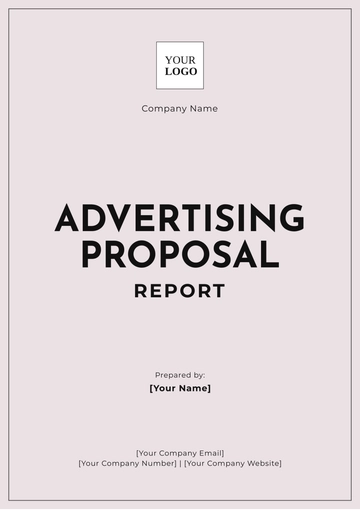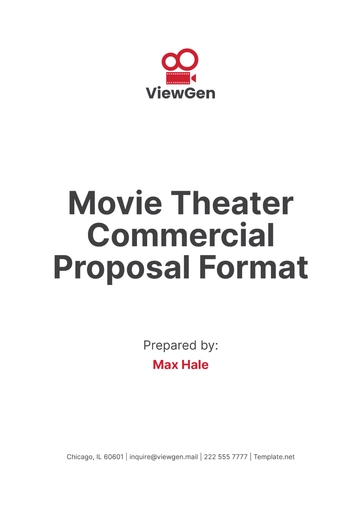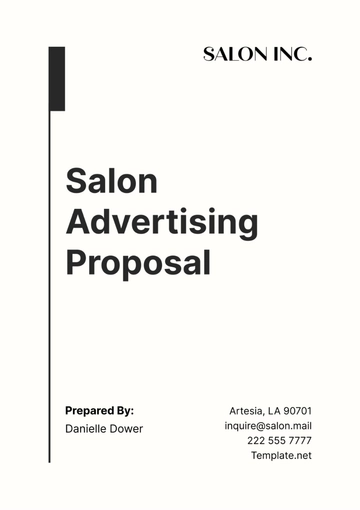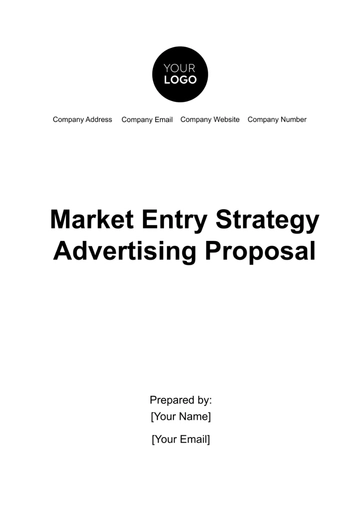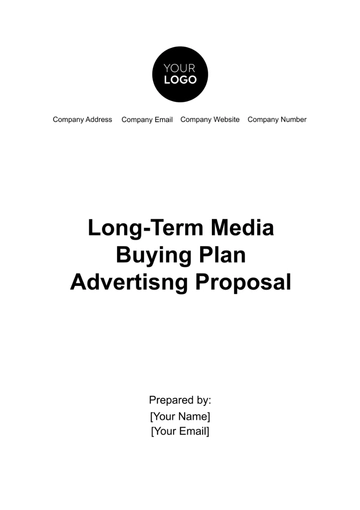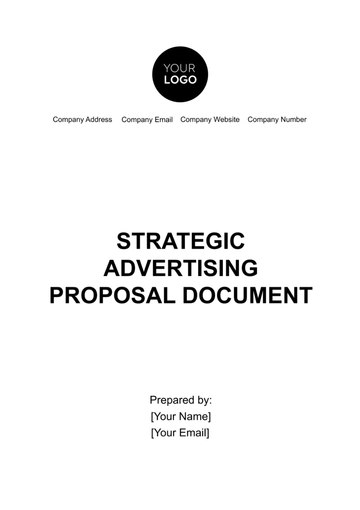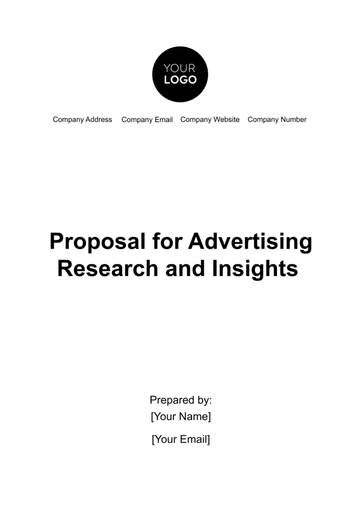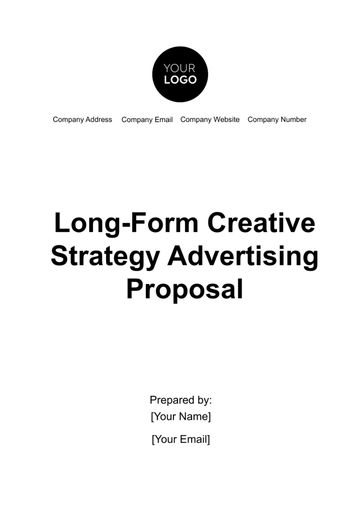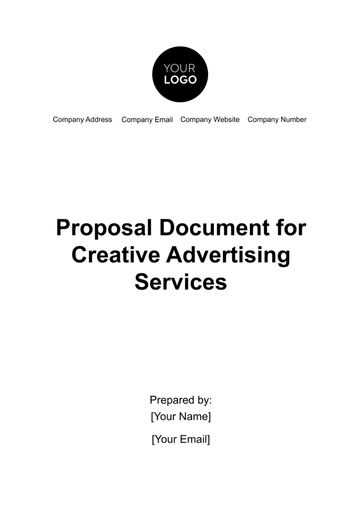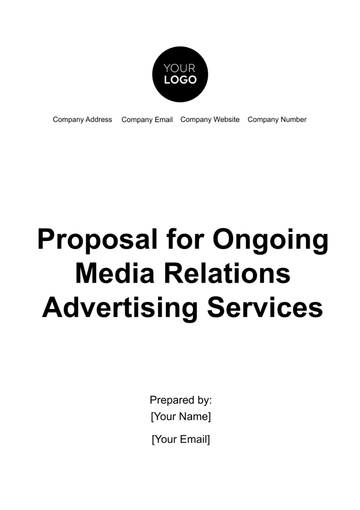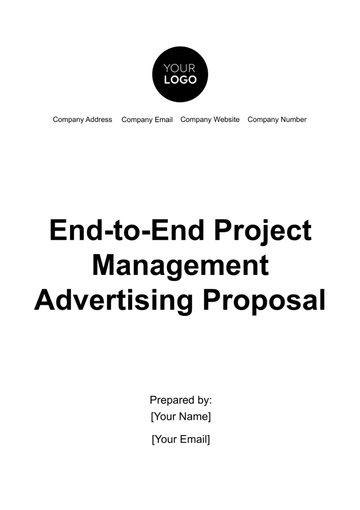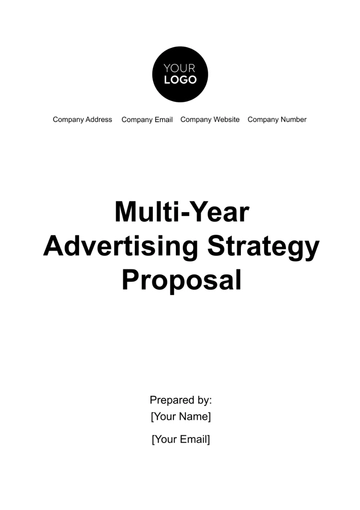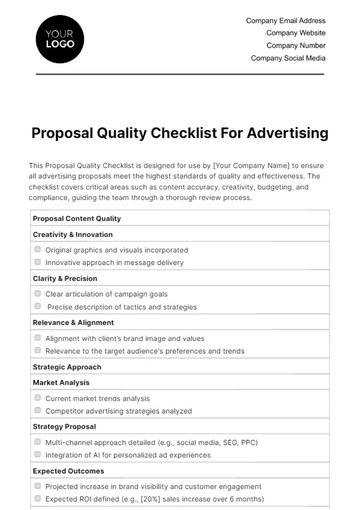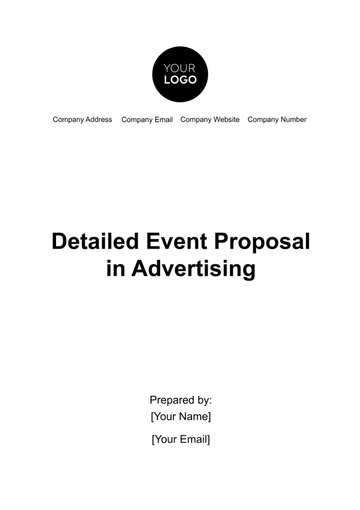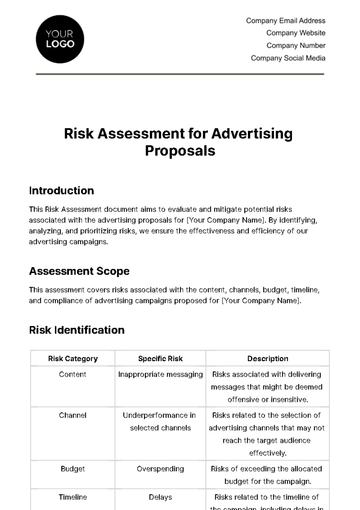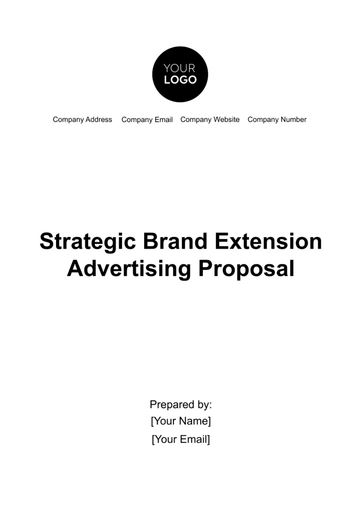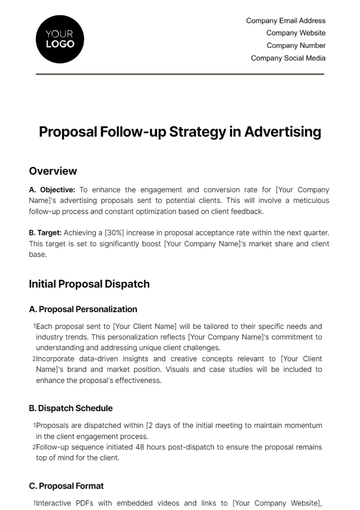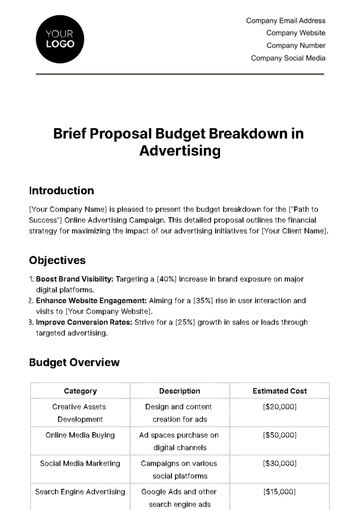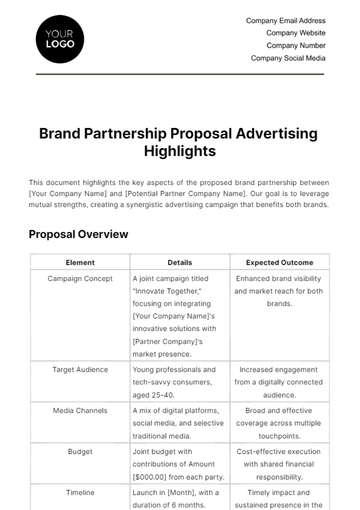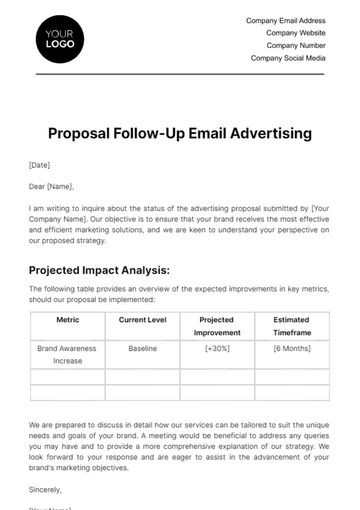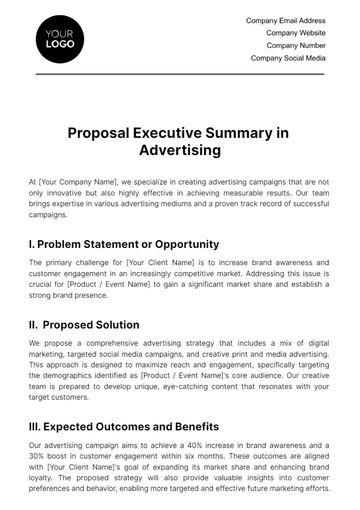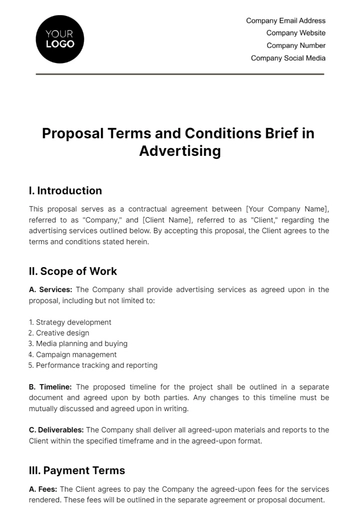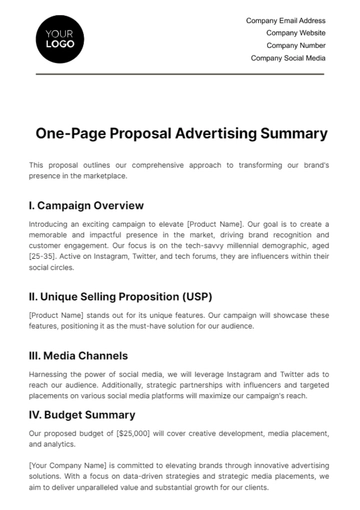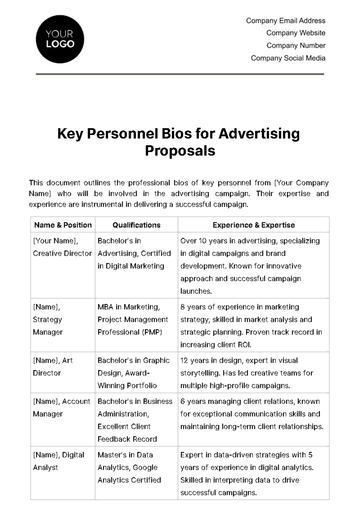Free Movie Theater Commercial Proposal Format
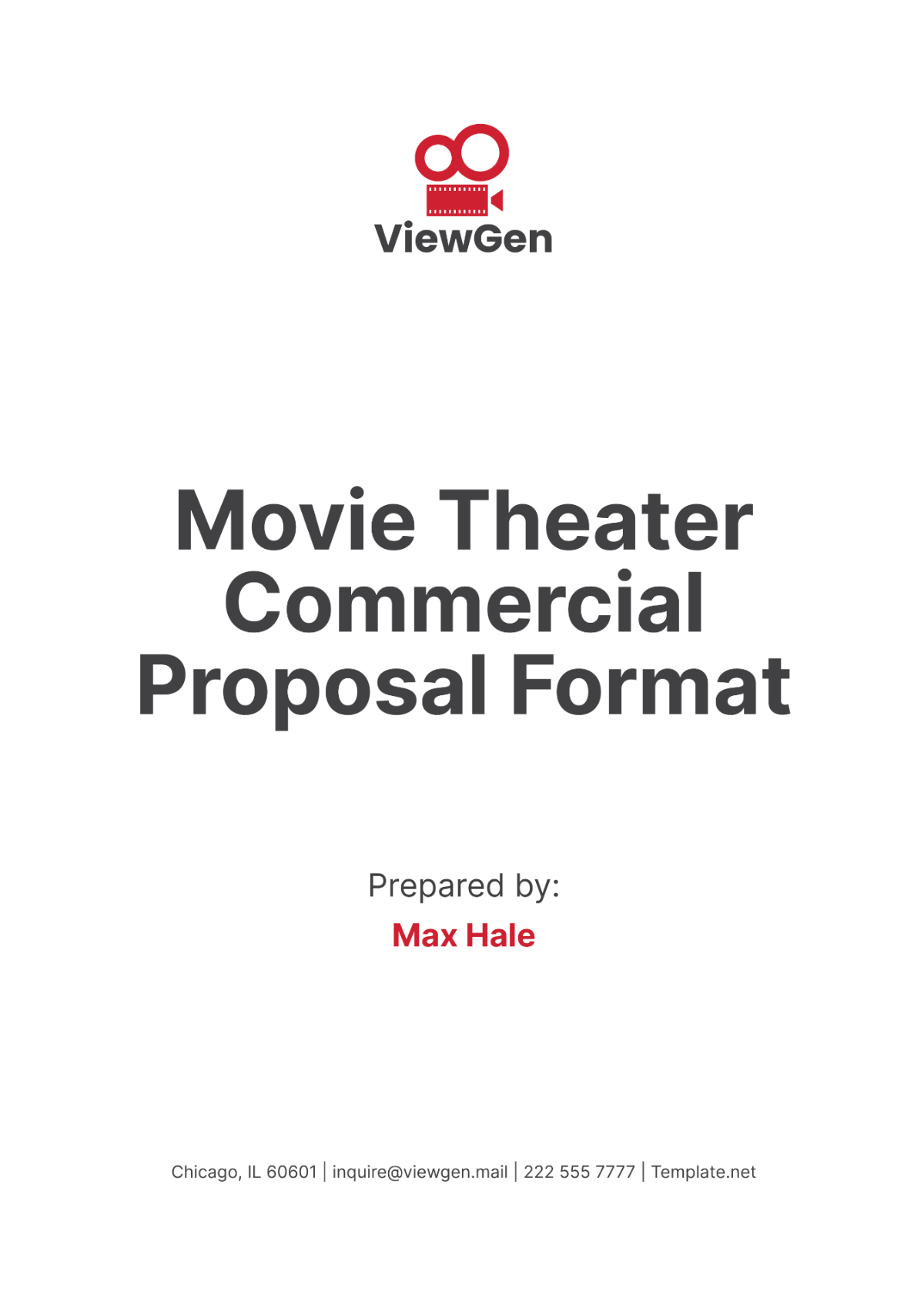
I. Executive Summary
[Your Company Name] is a leading movie theater business dedicated to providing exceptional cinematic experiences to our customers. This Movie Theater Commercial Proposal outlines our plan to launch a commercial campaign aimed at increasing audience engagement, boosting ticket sales, and enhancing brand visibility. The total budget for this campaign is $250,000, and the timeline for implementation is six months.
The campaign will encompass various marketing strategies, including digital advertising, social media promotions, in-theater events, and partnerships with local businesses. Our goal is to attract a broader audience, retain loyal customers, and create a memorable movie-going experience. By leveraging our strengths and addressing current market trends, we aim to achieve significant growth and solidify our position as the top choice for moviegoers in our region.
This proposal details the key components of our campaign, including market analysis, target audience, marketing strategies, budget allocation, and projected outcomes. By executing this proposal, we anticipate a substantial increase in ticket sales, enhanced customer satisfaction, and strengthened brand loyalty.
II. Market Analysis
The following table provides an overview of the current market conditions and competitive landscape:
No. | Factor | Description |
|---|---|---|
1 | Market Size | Estimated annual revenue of $500 million in the region |
2 | Competition | Presence of three major competitors with varying market shares |
3 | Audience Demographics | Predominantly young adults aged 18-34 |
4 | Trends | Increasing preference for premium cinema experiences |
A. Market Size
Revenue Estimates: The movie theater market in our region generates an estimated annual revenue of $500,000,000. This figure highlights the significant potential for growth and the importance of capturing a larger market share.
Growth Potential: The market has shown consistent growth over the past five years, with an average annual increase of 5%. This trend indicates a stable demand for movie theater experiences and opportunities for expansion.
B. Competition
Major Players: There are three major competitors in the region, each with varying market shares and service offerings. Understanding their strengths and weaknesses will help us differentiate our brand and attract their customers.
Competitive Advantage: Our unique selling points, such as advanced screening technology and exceptional customer service, provide a competitive advantage. Highlighting these features in our marketing campaign will set us apart from competitors.
C. Audience Demographics
Target Audience: The primary audience consists of young adults aged 18-34, who are frequent moviegoers and highly active on social media. This demographic is critical for driving ticket sales and engaging with our brand.
Engagement Strategies: Tailoring our marketing strategies to appeal to this audience, such as social media promotions and influencer partnerships, will enhance engagement and attract more customers.
D. Trends
Premium Experiences: There is an increasing preference for premium cinema experiences, such as VIP seating and enhanced audiovisual technology. Incorporating these features into our theaters will attract customers seeking high-quality entertainment.
Technological Integration: Integrating the latest technology, such as mobile ticketing and personalized recommendations, will enhance the customer experience and streamline operations.
III. Target Audience
The following table outlines the key characteristics of our target audience:
No. | Demographic | Description |
|---|---|---|
1 | Age Group | 18-34 years old |
2 | Gender | Balanced male and female representation |
3 | Interests | Technology, entertainment, and social media |
4 | Income Level | Middle to upper-middle class |
A. Age Group
Young Adults: Our primary target audience consists of young adults aged 18-34, who are avid moviegoers and trendsetters. This group is highly influential and active in recommending experiences to their peers.
Engagement Potential: Young adults are highly engaged on digital platforms, making them accessible through online marketing channels. Focusing on this age group will maximize our reach and impact.
B. Gender
Balanced Representation: Our target audience has a balanced representation of males and females, allowing us to create inclusive marketing campaigns. Addressing the preferences of both genders will broaden our appeal and attract a diverse audience.
Inclusive Campaigns: Creating inclusive and relatable campaigns that resonate with both genders will foster a stronger connection with our audience and encourage repeat visits.
C. Interests
Entertainment Enthusiasts: Our audience has a keen interest in entertainment, technology, and social media. Leveraging these interests in our marketing strategies will capture their attention and drive engagement.
Content Consumption: This demographic consumes a significant amount of content online, making them responsive to digital marketing efforts. Targeting their interests will increase the effectiveness of our campaigns.
D. Income Level
Middle to Upper-Middle Class: Our target audience primarily falls within the middle to upper-middle class income brackets, allowing for discretionary spending on entertainment. This economic stability supports frequent visits to our theaters.
Spending Power: Understanding the spending power of our audience will help us tailor our pricing strategies and promotions to maximize revenue and attract customers.
IV. Marketing Strategies
The following table outlines our key marketing strategies and their components:
No. | Strategy | Description |
|---|---|---|
1 | Digital Advertising | Online ads targeting social media platforms |
2 | In-Theater Promotions | Special events and promotions within the theater |
3 | Community Engagement | Partnerships with local businesses and organizations |
4 | Loyalty Programs | Reward programs for frequent customers |
A. Digital Advertising
Social Media Ads: We will run targeted ads on popular social media platforms, such as Facebook, Instagram, and Twitter. These ads will highlight upcoming releases, special promotions, and unique features of our theaters to attract a broader audience.
Influencer Partnerships: Collaborating with social media influencers who have a strong following among our target demographic will amplify our reach and credibility. Influencers can create engaging content that promotes our theater and drives traffic to our website and social media pages.
SEO and SEM: Investing in search engine optimization (SEO) and search engine marketing (SEM) will improve our online visibility and drive organic traffic to our website. These efforts will ensure that potential customers find us easily when searching for movie theaters in our region.
B. In-Theater Promotions
Special Events: Hosting special events, such as premiere nights, theme nights, and Q&A sessions with filmmakers, will create excitement and draw in large crowds. These events provide unique experiences that set us apart from competitors.
Discount Days: Implementing discount days, such as “Two-for-One Tuesdays” or “Student Discount Thursdays,” will attract price-sensitive customers and increase attendance on typically slower days. These promotions will encourage repeat visits and build customer loyalty.
Merchandise Sales: Offering branded merchandise, such as T-shirts, mugs, and posters, will create additional revenue streams and enhance brand visibility. Merchandise can also serve as promotional tools when worn or used by customers.
C. Community Engagement
Local Partnerships: Partnering with local businesses, such as restaurants and retail stores, will create mutually beneficial relationships and expand our reach. Cross-promotions and joint events will attract new customers from different segments of the community.
Charity Events: Hosting charity events and collaborating with local non-profit organizations will demonstrate our commitment to the community and enhance our reputation. These events will also provide positive publicity and attract socially-conscious customers.
Sponsorships: Sponsoring local events, such as sports games, festivals, and school activities, will increase our visibility and create positive associations with our brand. Sponsorships allow us to reach new audiences and strengthen our community presence.
D. Loyalty Programs
Reward Points: Implementing a loyalty program that rewards customers with points for each visit or purchase will incentivize repeat business. Points can be redeemed for free tickets, concessions, or exclusive merchandise.
Membership Tiers: Creating membership tiers with increasing benefits, such as early access to tickets, special discounts, and VIP seating, will encourage customers to engage more frequently with our theater. This tiered approach fosters long-term loyalty and increases customer retention.
Exclusive Offers: Offering exclusive deals and promotions to loyalty program members will make them feel valued and appreciated. These offers can include birthday discounts, early access to new releases, and invitations to special events.
V. Budget Allocation
The following chart and table outline the budget allocation for the proposed marketing strategies:
No. | Strategy | Budget Allocation |
|---|---|---|
1 | Digital Advertising | $100,000 |
2 | In-Theater Promotions | $50,000 |
3 | Community Engagement | $50,000 |
4 | Loyalty Programs | $50,000 |
Total | $250,000 |
A. Digital Advertising
Social Media Ads: Allocating $60,000 to social media ads will ensure we have a strong online presence and reach our target audience effectively. This budget covers ad creation, targeting, and placement costs.
Influencer Partnerships: $20,000 will be dedicated to influencer partnerships, allowing us to collaborate with popular influencers and leverage their reach to promote our theater. This budget includes compensation for influencers and production costs for promotional content.
SEO and SEM: The remaining $20,000 will be invested in SEO and SEM efforts to enhance our online visibility and drive organic traffic. This includes hiring SEO specialists, purchasing ad space, and optimizing our website.
B. In-Theater Promotions
Special Events: $25,000 will be allocated to hosting special events, covering costs for event planning, marketing, and execution. This includes expenses for decorations, entertainment, and promotional materials.
Discount Days: $15,000 will be set aside for discount day promotions, including marketing and advertising costs to raise awareness of these deals. This budget also covers any potential revenue loss from discounted ticket prices.
Merchandise Sales: The remaining $10,000 will be used to produce and promote branded merchandise. This includes manufacturing costs, marketing materials, and distribution expenses.
C. Community Engagement
Local Partnerships: $20,000 will be allocated to forming local partnerships and executing cross-promotions with nearby businesses. This budget covers collaboration costs, joint marketing efforts, and event expenses.
Charity Events: $15,000 will be dedicated to hosting charity events and collaborating with local non-profits. This includes event planning, marketing, and donation costs.
Sponsorships: The remaining $15,000 will be used for sponsoring local events, providing funds for sponsorship fees, marketing materials, and promotional activities.
D. Loyalty Programs
Reward Points: $20,000 will be allocated to implementing and managing the loyalty program, including technology costs for tracking points and redeeming rewards. This budget also covers marketing and promotional materials for the program.
Membership Tiers: $15,000 will be used to create and promote membership tiers, covering costs for developing benefits, marketing the program, and managing member interactions.
Exclusive Offers: The remaining $15,000 will be dedicated to providing exclusive offers and promotions to loyalty program members. This includes the cost of discounted tickets, special events, and marketing materials.
VI. Timeline
The following table outlines the timeline for implementing the proposed marketing strategies:
No. | Phase | Duration |
|---|---|---|
1 | Planning | 1 month |
2 | Execution | 4 months |
3 | Evaluation | 1 month |
A. Planning
Initial Research: The planning phase will begin with initial research and analysis to refine our marketing strategies. This process will take approximately two weeks and involve market research, competitor analysis, and audience profiling.
Strategy Development: The next two weeks will be dedicated to developing detailed marketing strategies, including digital advertising plans, in-theater promotions, community engagement initiatives, and loyalty programs. This phase will also involve budget allocation and timeline finalization.
B. Execution
Launch Campaigns: The execution phase will start with the launch of digital advertising campaigns, including social media ads and influencer partnerships. This process will take one month, during which we will monitor and adjust the campaigns as needed to maximize their effectiveness.
Implement In-Theater Promotions: In-theater promotions, such as special events and discount days, will be implemented over the next two months. This phase will also involve the production and sale of branded merchandise.
Community Engagement: Community engagement initiatives, including local partnerships, charity events, and sponsorships, will be executed throughout the four-month period. This phase will focus on building relationships and increasing our visibility within the community.
Launch Loyalty Programs: The loyalty programs will be launched and promoted during the final month of the execution phase. This process will include the implementation of reward points, membership tiers, and exclusive offers.
C. Evaluation
Performance Review: The evaluation phase will involve reviewing the performance of our marketing strategies over the past five months. This process will take approximately two weeks and include analyzing key metrics, such as ticket sales, customer engagement, and brand visibility.
Adjustments and Improvements: Based on the performance review, we will make any necessary adjustments and improvements to our marketing strategies. This phase will take another two weeks and involve refining our approach to ensure continued success.
VII. Projected Outcomes
The following table outlines the projected outcomes of our marketing campaign:
No. | Outcome | Description |
|---|---|---|
1 | Increased Ticket Sales | 20% increase in ticket sales within six months |
2 | Enhanced Brand Visibility | 30% increase in social media engagement and online presence |
3 | Improved Customer Loyalty | 15% increase in repeat customers through loyalty programs |
4 | Stronger Community Presence | 10% increase in partnerships and local engagement |
A. Increased Ticket Sales
Revenue Growth: We anticipate a 20% increase in ticket sales within six months of implementing our marketing campaign. This growth will result from targeted advertising, in-theater promotions, and enhanced customer engagement.
Audience Reach: By leveraging digital advertising and community engagement initiatives, we will expand our audience reach and attract new customers. This broader reach will contribute to the increase in ticket sales.
B. Enhanced Brand Visibility
Online Presence: We expect a 30% increase in social media engagement and online presence as a result of our digital advertising efforts and influencer partnerships. This increased visibility will strengthen our brand and attract more customers.
Brand Recognition: Enhanced brand visibility will lead to greater recognition and awareness among our target audience. This recognition will drive customer loyalty and encourage repeat visits.
C. Improved Customer Loyalty
Loyalty Program Success: We project a 15% increase in repeat customers through our loyalty programs. By offering rewards, exclusive offers, and membership benefits, we will incentivize customers to visit our theater more frequently.
Customer Satisfaction: Improved customer satisfaction from personalized experiences and premium offerings will contribute to higher loyalty and retention rates. Satisfied customers are more likely to recommend our theater to others.
D. Stronger Community Presence
Local Engagement: We anticipate a 10% increase in partnerships and local engagement through our community initiatives. Building strong relationships with local businesses and organizations will enhance our reputation and attract new customers.
Positive Publicity: Community engagement efforts, such as charity events and sponsorships, will generate positive publicity and enhance our standing within the community. This positive perception will drive customer trust and loyalty.
VIII. Risk Management
The following table outlines potential risks and mitigation strategies for our marketing campaign:
No. | Risk | Mitigation Strategy |
|---|---|---|
1 | Budget Overruns | Regular monitoring and contingency planning |
2 | Low Audience Engagement | Diversified marketing approaches and regular analysis |
3 | Operational Challenges | Efficient project management and staff training |
4 | Competitive Actions | Continuous market analysis and strategic adjustments |
A. Budget Overruns
Regular Monitoring: To prevent budget overruns, we will implement regular monitoring and tracking of expenses. This proactive approach will allow us to identify and address potential issues early on.
Contingency Planning: Allocating a portion of our budget as a contingency fund will provide a financial cushion for unexpected expenses. This strategy will ensure we remain within our overall budget.
B. Low Audience Engagement
Diversified Approaches: To mitigate the risk of low audience engagement, we will employ a diversified marketing approach that includes digital advertising, in-theater promotions, community engagement, and loyalty programs. This multi-faceted strategy will increase our chances of success.
Regular Analysis: Conducting regular analysis of our marketing efforts will help us identify areas for improvement and adjust our strategies accordingly. This continuous feedback loop will enhance our campaign's effectiveness.
C. Operational Challenges
Project Management: Efficient project management practices, such as setting clear goals, timelines, and responsibilities, will help us navigate operational challenges. Regular team meetings and progress reviews will ensure smooth execution.
Staff Training: Providing comprehensive training for our staff on new processes and technologies will minimize operational disruptions. Well-trained staff will be better equipped to handle challenges and deliver exceptional service.
D. Competitive Actions
Market Analysis: Continuous market analysis will help us stay informed about competitor actions and industry trends. This knowledge will allow us to make strategic adjustments and maintain our competitive edge.
Strategic Adjustments: Being agile and responsive to changes in the market will enable us to adapt our strategies as needed. This flexibility will ensure we remain competitive and capitalize on new opportunities.
IX. Conclusion
This Movie Theater Commercial Proposal outlines a comprehensive commercial campaign designed to enhance the visibility, engagement, and profitability of [Your Company Name]. With a total budget of $250,000, our strategic allocation of funds across digital advertising, in-theater promotions, community engagement, and loyalty programs will drive significant growth and achieve our business objectives.
By following the proposed timeline and implementing robust risk management strategies, we will maximize the impact of our marketing efforts and ensure long-term success. We are confident that this campaign will result in increased ticket sales, enhanced brand visibility, improved customer loyalty, and a stronger community presence, ultimately solidifying [Your Company Name]'s position as a leading movie theater in the region.
- 100% Customizable, free editor
- Access 1 Million+ Templates, photo’s & graphics
- Download or share as a template
- Click and replace photos, graphics, text, backgrounds
- Resize, crop, AI write & more
- Access advanced editor
Present your commercial proposal effectively using a standardized format with the Movie Theater Commercial Proposal Format Template! This editable template only here on Template.net is designed to outline proposals clearly. It is customizable to fit your specific requirements, and the advanced AI Editor Tool ensures seamless modifications and updates immediately!
You may also like
- Business Proposal
- Research Proposal
- Proposal Request
- Project Proposal
- Grant Proposal
- Photography Proposal
- Job Proposal
- Budget Proposal
- Marketing Proposal
- Branding Proposal
- Advertising Proposal
- Sales Proposal
- Startup Proposal
- Event Proposal
- Creative Proposal
- Restaurant Proposal
- Blank Proposal
- One Page Proposal
- Proposal Report
- IT Proposal
- Non Profit Proposal
- Training Proposal
- Construction Proposal
- School Proposal
- Cleaning Proposal
- Contract Proposal
- HR Proposal
- Travel Agency Proposal
- Small Business Proposal
- Investment Proposal
- Bid Proposal
- Retail Business Proposal
- Sponsorship Proposal
- Academic Proposal
- Partnership Proposal
- Work Proposal
- Agency Proposal
- University Proposal
- Accounting Proposal
- Real Estate Proposal
- Hotel Proposal
- Product Proposal
- Advertising Agency Proposal
- Development Proposal
- Loan Proposal
- Website Proposal
- Nursing Home Proposal
- Financial Proposal
- Salon Proposal
- Freelancer Proposal
- Funding Proposal
- Work from Home Proposal
- Company Proposal
- Consulting Proposal
- Educational Proposal
- Construction Bid Proposal
- Interior Design Proposal
- New Product Proposal
- Sports Proposal
- Corporate Proposal
- Food Proposal
- Property Proposal
- Maintenance Proposal
- Purchase Proposal
- Rental Proposal
- Recruitment Proposal
- Social Media Proposal
- Travel Proposal
- Trip Proposal
- Software Proposal
- Conference Proposal
- Graphic Design Proposal
- Law Firm Proposal
- Medical Proposal
- Music Proposal
- Pricing Proposal
- SEO Proposal
- Strategy Proposal
- Technical Proposal
- Coaching Proposal
- Ecommerce Proposal
- Fundraising Proposal
- Landscaping Proposal
- Charity Proposal
- Contractor Proposal
- Exhibition Proposal
- Art Proposal
- Mobile Proposal
- Equipment Proposal
- Student Proposal
- Engineering Proposal
- Business Proposal

